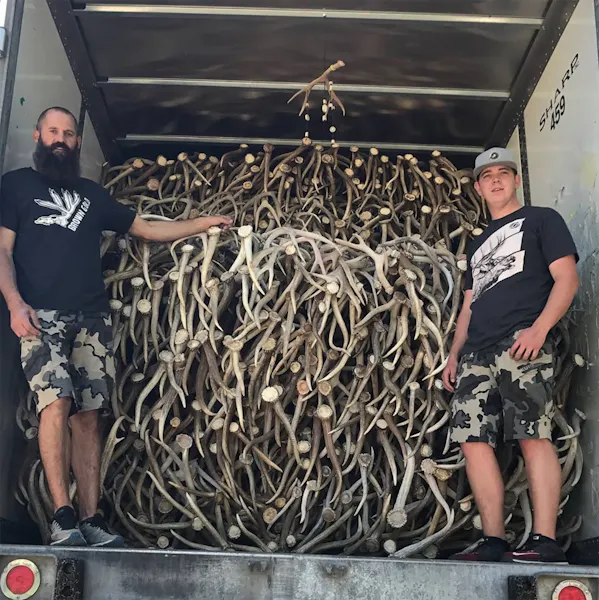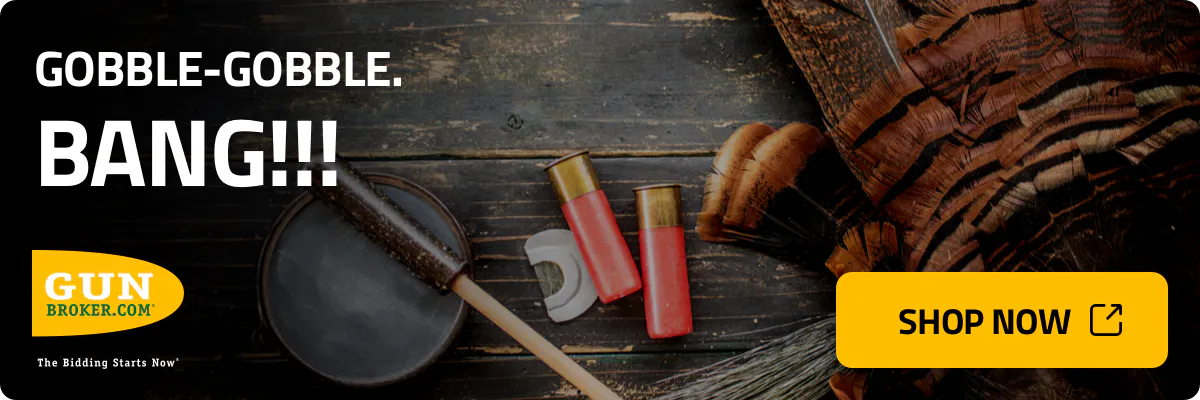- Stories
- Q&A: Shed Hunting Tips from the Legend, Steve Sorensen


Q&A: Shed Hunting Tips from the Legend, Steve Sorensen


Shed hunting and antler buying legend, Steve Sorensen, stands on the left with one of his well-known semi-trailers full of bone.
AUTHOR: BRAD LUTTRELL, GOWILD CO-FOUNDER
Shed hunting can be hard, but even a bad day shed hunting is still a good day overall. To me, if you're outside, working off those holiday calories and enjoying the outdoors, it's a success. However, it is nice to bag some bone if you're truly out there in search of it. Otherwise, it's not shed hunting—it's just "hiking."
Maybe it was self-beneficial, or maybe it was just my own curiosity to learn more about what he does, but I decided we had to talk to Steve Sorensen. I'm so glad I called him. Steve's interview gave me new perspective on the fun activity of shed hunting, and I even learned a thing or two about deer behavior and biology.
Even if you've been a shed hunter for years, I ask you to read Steve's whole interview. He talks about some controversial topics, how to avoid over pressuring deer, and discusses the ethics behind shed traps. This is a worthwhile read.
Also, remember to log your shed hunting time in the GoWild™ app so you can get credit and show off your hard work!
Alright, enough of me. Let's get to my chat with Steve. Enjoy!
GoWild: First, for anyone who doesn’t participate, can you explain why someone would want to shed hunt and collect antlers?
Steve: It’s kind of like the opening day of the deer hunt but it lasts year-round, no applying or drawing a tag necessary. Deer, elk and moose lose their antlers each year and people of all walks of life gather them up. I was intrigued by it at the age of 7 and can remember my first time vividly. I think a lot of my generation looked at the trophy magazines and got started that way, when we figured out they dropped their antlers.

Steve didn't just become an Antler Buyer overnight. He put years of legwork into finding, selling and utilizing his antlers before he suddenly was the antler guy.
GoWild: That’s awesome that you got started so young. Now, please tell us a bit more about who you are and how you got into Buying Antlers.
Steve: I was finding quite a bit of sheds and selling them but I just didn’t feel like some of the antler buyers were treating me as fair as I should have been treated. I started crafting, building antler chandeliers, lamps, tables etc and was getting more out of my sheds that way. I was guiding hunters at the time and selling my stuff from the lodge. When I couldn’t supply myself with antlers anymore I started buying from a few friends. Next thing I knew I was an Antler Buyer.
GoWild: How are the sheds you sell being used? I’m always curious where those are going when I see you standing in front of a semi-trailer loaded with them.
Steve: About half of our antlers go to Dog Chews, and half go to China. In China, they use them for medicinal purposes. Antler is fast growing and full of glucosamine and chondroitin. It’s used to prevent and treat arthritis. In the United States, we use other fast-growing tissues, but there is nothing faster growing than antlers, so it’s better than anything else. You have over 2,000 recorded years of medicinal use of antler in Asia.

One of Steve's tips is to look where no one else would look. Go places no one else would go. You may have a less populated area for deer, but you will also have less competition.
GoWild: That’s so cool though that you can take something that is literally on the earth and will just be chewed up by critters, and you turn it into something that helps people with aches and pains. OK, so for the beginners reading this blog, how do you go about getting started with shed hunting?
Steve: The first step is to locate deer two weeks to a month before they’re shedding. Do this from a distance so you don’t disturb them or chase them out of the area. The second step is to walk with your eyes—AKA glassing—and take a pair of binoculars and get on a high point. You’ll find 10 times more antlers by using a pair of binoculars. Step three? I always try to get back into areas that nobody thinks about going into. There’s lots of competition, so try to think out of the box.
GoWild: I know a lot of folks use dogs. Do you do that, or are you old school?
Steve: I’m old school but I have friends who use dogs. I would like to have a shed dog but buying antlers keeps me busy most of the shed season. For the beginners looking to get a dog, I think you need to learn the sport first. Figure out those pockets where the deer hang out and shed their antlers. If you don’t do that you’re wasting your time and the dog’s. Dogs are handy and can dig antlers out of two feet of snow but to be able to train one properly you’ll have to learn how to shed hunt first.
Logging your shed hunting into GoWild helps show off your effort and your finds. Download the app today.
GoWild: I know a lot of deer hunters like to shed hunt because it helps them prep for the season by knowing what deer made it through, and also just where the deer traffic is. What other hunting benefits come out of shed hunting?
Steve: Just being out in the mountains and getting away from the day to day rat race. It seems we are glued to our phones or a computer 24/7 these days. For me, it’s getting away from all that and enjoying the Outdoors. I always tell my friends that I go with, “It’s not always about the sheds, but more about getting out and the adventure.”
GoWild: Tell me about Sheds for Santa. What is that, and how’s it work?
Steve: Sheds for Santa was started by a friend of mine, Sawyer Peacock. When he was around 9 years old his Dad had a stroke and his family fell on some tough times. Some of their neighbors came together and surprised his family with Christmas.
In 2014, Sawyer had a family in his neighborhood who was down on their luck so he started Sheds for Santa to help them out. He collected antlers from friends and family and sold them to buy Christmas for them. The next year 2015 he set a goal to help 10 families and raised enough money to help 25. In 2016 people on social media started auctioning off their personal sheds to the highest bidder and giving the proceeds to Sheds for Santa. Sawyer had set a goal to help 25 families and was able to help out 48, thanks to the Hunting Community stepping up in a big way. In 2017, Sheds for Santa set a goal to help out 100 families and it was going to take around $50,000 to get it done. Once again, the hunting community stepped up and blew the goal out of the park. With around $62,000 raised Sawyer was able to help out 137 families.

GoWild: That’s really incredible. I know Sawyer has had a ton of love in the news and on podcasts for his effort, so I’m sure it will continue to grow. Now, I always see tricks being posted to social media about how to get sheds to fall off, but for those of us just hiking and searching properties (public and private), what tips do you have on where to look?
Steve: I like to look mainly in feeding and bedding areas. Fence lines can be good along with creek or steep ravine crossings. With that being said, an antler is not coming off until it’s ready and I’ve seen deer pack just one antler for a month. It’s not the norm, but I’ve seen it.
I think traps are unethical, they could potentially tangle an animal up and kill it. I’m totally against anything like that. Deer are baited in that process, whether through a homemade or purchased contraption. Mule deer have a really sensitive stomach. It takes their stomachs four days to get used to what they’re eating. If you’re feeding them, you’re actually doing more harm than good because it’s hurting their digestive system.
GoWild: Wow, I had no clue they made commercial antler retrieval systems. Well, what have I missed? Anything you’d want folks to know?
Steve: Watch what you’re doing during those long winter months and respect the deer. If it’s a bad winter, or the deer are struggling, don’t push them. Respect the natural resource and respect the animal. Deer come into a winter with a certain amount of fat, and they rely on that fat to get them through the winter. They usually can’t add to their fat reserves during winter months. When people are running deer through deep snow, it’s really hard on them and It burns the fat which is key to their survival.
Steve runs his business through his Instagram profile. Find him at @antlerbuyer1976.

